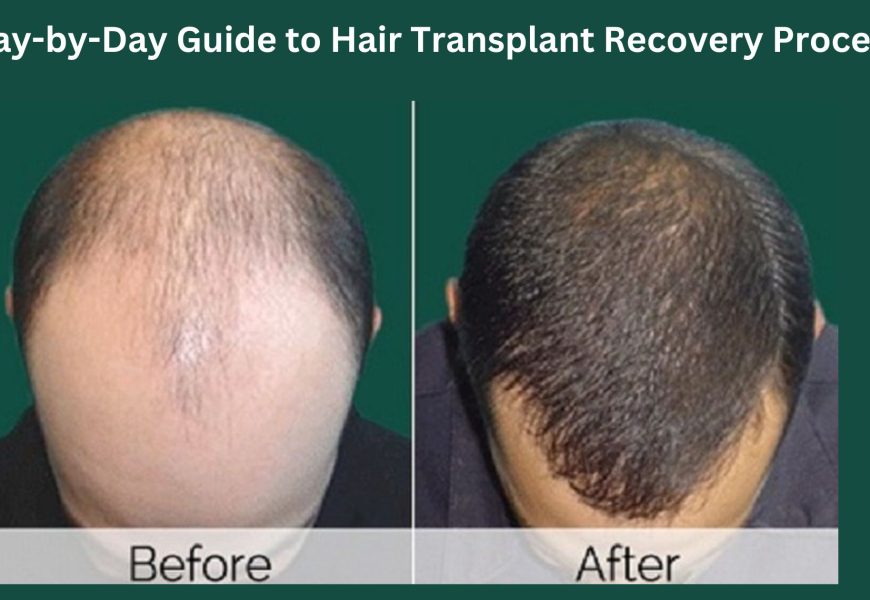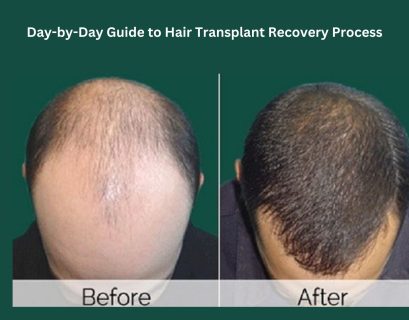Hair transplants represent a common remedy for those experiencing hair loss. With the increasing interest in this procedure, numerous individuals are looking for understanding regarding the recovery process. Understanding the Hair Transplant Recovery Day By Day process is essential for a smooth and successful experience. This guide outlines what to expect during recovery, offering a comprehensive look at the journey from the first 24 hours to the complete restoration of your hairline.
What is a Hair Transplant?
A hair transplant is a surgical operation where hair follicles are moved from a section of the scalp, usually one with a lot of hair, to a balding or thinning region. There are two methods: Follicular Unit Extraction (FUE) & Follicular Unit Transplantation (FUT). Both approaches have differences but end up doing the same thing-to make your hairline look fuller and more natural. It’s very important to know how this process happens because it has a strong impact on your Hair Transplant Recovery Day By Day. The more you know in advance, the better prepared you are to face the healing process.
Hair Transplant Process: What to Expect
Prior to having a hair transplant, it is essential to consult with a hair restoration expert. This meeting enables the physician to evaluate your situation, suggest the correct procedure, and offer pre-operative guidelines. On the day of the operation, the surgeon will extract hair follicles from the donor region and place them into the hairless areas. Regardless of whether you choose FUE or FUT, the recovery journey will progress in a typical manner, and comprehending this Hair Transplant Recovery Day By Day is crucial.
After the surgery, the surgeon will provide aftercare instructions that you must follow closely. This will include guidance on washing your hair, avoiding physical activity, and preventing irritation to the newly transplanted follicles. Proper post-operative care will significantly impact the overall success of your transplant.
Hair Transplant Recovery: What to Expect During the Healing Phase
The Hair Transplant Recovery Day By Day process consists of several stages. Let’s break down what to expect as your scalp heals:
Day 1: The First 24 Hours
Recovery begins right away following surgery. In the initial 24 hours, you will notice swelling, redness, and discomfort around both the donor and recipient areas. The surgeon will typically give you pain medication to help with any discomfort and might suggest using antibiotic ointment to prevent infection. Sleeping with your head elevated and following any instructions for hygiene strictly is essential at this point.
Day 2 to 3: Swelling and Scabbing
Swelling typically peaks in the first 48 hours after surgery. By Day 3, the swelling begins to subside, but scabs will start to form around the transplanted follicles. It is crucial to refrain from touching or scratching the scalp, since this can interfere with the healing process. During this period, you may notice slight tightness or sensitivity around the grafts, which is normal. Following the washing and scalp care instructions provided by your surgeon will ensure that the healing process continues smoothly.
Day 4 to 7: The Healing Process Continues
By the end of the first week, the swelling and redness should be significantly reduced. Scabs around the transplanted hair follicles will naturally begin to shed. This is a good sign that the healing process is progressing well. However, it’s crucial to avoid direct sun exposure and refrain from any strenuous activities that might irritate your scalp. As the donor area heals, you’ll also begin to notice some tenderness around the area from where the hair follicles were harvested.
Week 2: The Shedding Phase
During the second week, many patients will begin to experience shedding from the transplanted area. This is part of the Hair Transplant Recovery Day By Day process and is entirely normal. It may seem alarming, but this shedding is temporary and actually a sign that your hair follicles are adjusting and preparing for new growth. It is important to remain patient, as new hair development will begin shortly. To avoid irritating the scalp, continue to follow the care guidelines provided by your surgeon.
Week 3 to 4: Follicles Settle In
Around Week 3 to 4, the transplanted hair follicles will begin to settle in and establish their roots. During this period, early signs of hair growth may appear. Although the hair may be thin at first, it will gradually become thicker and more visible. You might experience some itching as the scalp adjusts, but avoid scratching as this can disrupt the healing process. Patience is essential at this phase, and adequate scalp care is vital to encourage the healthy regrowth of hair.
Month 2 to 3: The Growth Phase
By Month 2 to 3, the Hair Transplant Recovery Day By Day timeline begins to show more visible progress. Fine hairs will start to appear, and the hairline will become more defined. Continued shedding of weak hairs is a part of the process, but the newly transplanted follicles will eventually replace them with stronger, thicker hair. To ensure proper hair regrowth, keep the scalp clean and moisturized. You may notice early signs of volume and thickness starting to return to your hair.
Month 4 to 6: A Visible Transformation
As you move into the 4th to 6th month of recovery, the growth becomes much more noticeable. The transplanted hairs will become thicker, darker, and more natural-looking. The hairline will continue to improve, and the overall volume of hair will increase. Throughout this period, it’s crucial to maintain a healthy hair care routine, including protecting your scalp from harsh sun exposure and using gentle hair products.
Month 6 to 12: Full Hair Growth and Natural Look
By the time 6 to 12 months pass, you should see the full results of your hair transplant. The hair should be fully grown, with a significant improvement in density. The freshly transplanted hair will integrate flawlessly with your existing hair, providing you with a complete, natural-looking hairline. Continue your post-transplant care to ensure long-lasting results.
Key Takeaways for Hair Transplant Recovery
- Patience is Key: The Hair Transplant Recovery Day By Day journey requires patience as results will gradually appear over time.
- Follow Aftercare Instructions: Proper aftercare is crucial for ensuring the health of the transplanted hair.
- Shedding is Normal: Expect shedding in the first few weeks as the old hair falls out to make room for new growth.
- Protect Your Scalp: Avoid sun exposure and irritation, which can affect the healing process.
- Long-Term Care: Maintain regular follow-up appointments with your surgeon to ensure long-term success.
Conclusion
Understanding what happens in your recovery day to day is how you set proper expectations and get the best possible outcomes. It takes time from that first 24 hours until hair grows full, but with proper care and patience, you achieve natural, fuller-looking hair. If you are considering a hair transplant, seek professional guidance from Beverly Hills Hair Restoration, where experts are always ready to guide you through every stage of the process to attain optimal results.










